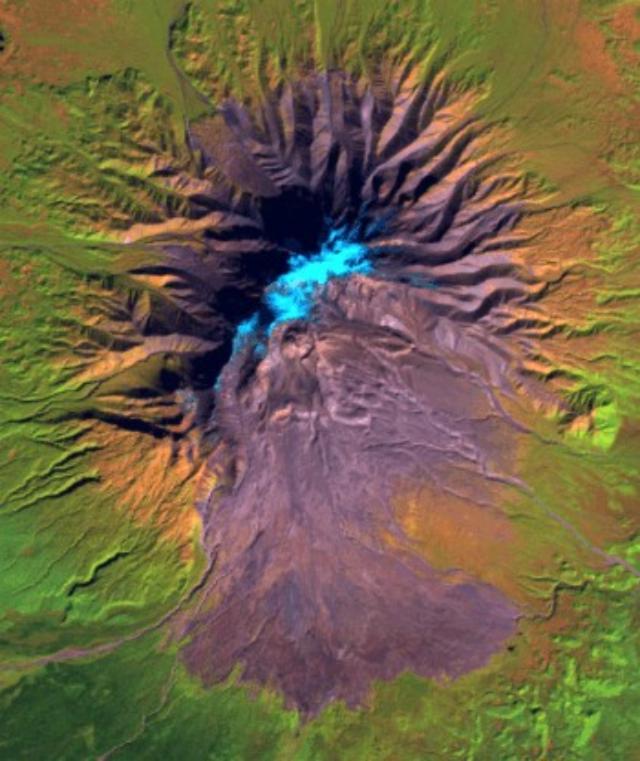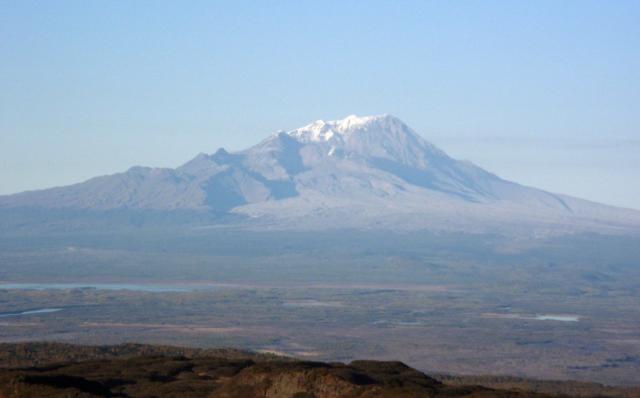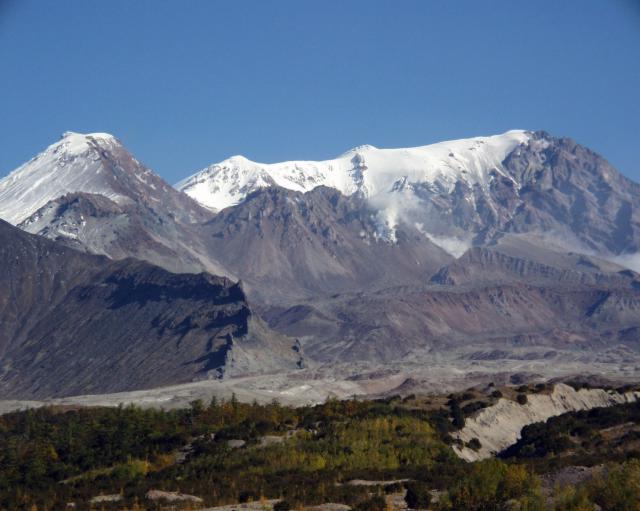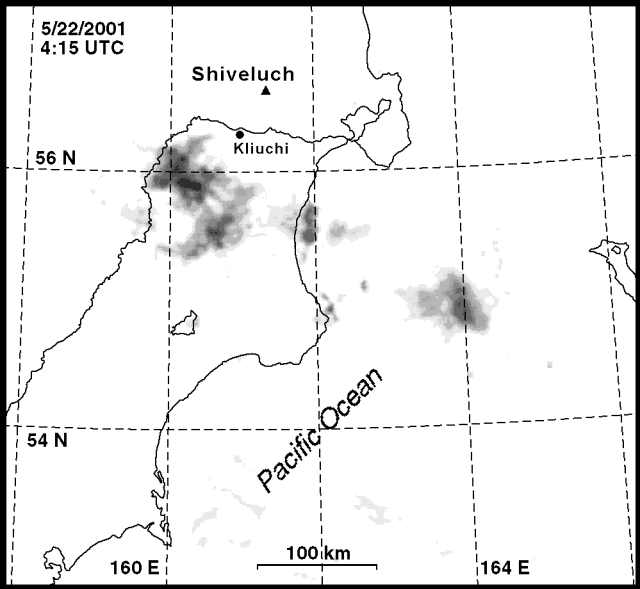Report on Sheveluch (Russia) — April 2001
Bulletin of the Global Volcanism Network, vol. 26, no. 4 (April 2001)
Managing Editor: Richard Wunderman.
Sheveluch (Russia) Hazard status reaches Red; new dome formation during May 2001
Please cite this report as:
Global Volcanism Program, 2001. Report on Sheveluch (Russia) (Wunderman, R., ed.). Bulletin of the Global Volcanism Network, 26:4. Smithsonian Institution. https://doi.org/10.5479/si.GVP.BGVN200104-300270
Sheveluch
Russia
56.653°N, 161.36°E; summit elev. 3283 m
All times are local (unless otherwise noted)
At Shiveluch (figures 4, 5, and 6) elevated volcanic activity occurred during 15 December 2000-22 May 2001. The character of the activity had not changed significantly since the previous report (BGVN 25:11). On 15 December 2000 at 2105 seismicity indicated a possible gas-and-ash explosion. On 20 December gas-and-steam plumes rose 200-300 m above the volcano.
Late December 2000: Hazard Status Yellow. The Level of Concern Color Code was raised from Green to Yellow during late December 2000. On 29 December at 0743 seismographs registered shallow earthquakes and a short-lived explosion was inferred to send ash and gas ~2,000-3,000 m above the summit. Gas-and-steam plumes continued to rise through the end of the month.
During 31 December 2000-1 February 2001 similar activity continued, featuring shallow seismicity, small gas-and-ash explosions, and fumarolic emissions. A Yellow hazard status remained in effect. On 2 February at 1100 a powerful gas-and-ash plume rose 800 m above the volcano and extended 3 km W. Visual reports from the nearby community of Kliuchi, 50 km SW of the summit, suggested that another short-lived explosive eruption the same day at 1804 sent an ash plume to a height of 2,000 m; a coeval shallow two-minute-duration event was recorded by seismographs more than 110 km from the volcano. From 1807 to 1825 strong volcanic tremor was registered.
Gas-and-steam plumes that rose up to 1,200 m predominated until 19-20 February when seismographs recorded a series of two-and-four-minute-long shallow earthquakes that may have indicated weak explosions. Two-and-three-minute-long series of shallow earthquakes were recorded on 25 and 27 February, again possibly indicating weak gas-and-ash explosions; minor volcanic tremor followed.
Similar shallow earthquakes and explosions (?) took place during 2-6 March. On 7 March seismic data and visual observations from Kliuchi indicated a 1,500-m-high ash-and-gas plume that extended NW. Ash reports were issued by the Tokyo Volcanic Ash Advisory Center (VAAC). According to information from Elizovo airport (~ 450 km SSW of Shiveluch), at 1620 pilots aboard flight #74052 flying at 8,100 m altitude observed an ash plume ~10 km above Shiveluch that extended 30 km NE. Satellite images processed by the Alaska Volcano Observatory (AVO) from 1715 showed bifurcations of the plume. One composed mostly of steam extended E from the volcano at a low altitude while the other stretched 50 km N at an altitude of 7-8 km. Short series of shallow earthquakes and spasmodic volcanic tremor continued to be recorded.
24 April 2001: Hazard Status Orange. Fumarolic emissions, series of seismic events, and inferred explosions occurred through mid-April. The Tokyo VAAC issued an ash advisory to aviators on 6 April. On 22 April seismicity increased sharply. Earthquakes of MBGVN 18:03 and 18:04); KVERT raised the hazard status from Yellow to Orange on 24 April. Cloudy conditions prevented direct observation of Shiveluch's status through 28 April. The energy of individual events increased (up to M ~3.4) through 25 April, and further increased in number and energy the following day. On the morning of 27 April a M ~ 4 event occurred. Beginning on 28 April the quantity and intensity of the events began to decrease slightly. Gas-and-steam plumes were visible up to 700 m above the crater and extended 5 km W. A satellite image processed by AVO taken on 30 April at 0739 showed a four-pixel thermal anomaly at the volcano.
Seismicity began to increase again on 1 May with continued shallow earthquakes and weak spasmodic tremor episodes. A satellite image captured on 2 May at 0652 showed a very weak three-pixel thermal anomaly. By 1757 the following day a satellite image showed a three-to-four-pixel thermal anomaly with two pixels at or near saturation. On 4 May the anomaly had temperatures of 16-25°C against a background of -5-0°C. An ash advisory was issued by the Tokyo VAAC on 6 May.
7 May 2001: New Dome Formation. According to seismicity, eruptive activity initiated on 7 May at 0958 when strong spasmodic volcanic tremor began to occur. Visual reports from Kliuchi at 1015 indicated that a gas-and-ash plume rose ~1,200 m and extended NW; ash fell on the town. AVO satellite imagery showed the plume extending ~40 km WNW by 2026. Small pyroclastic flows were visible on the SW slopes of the dome. On 12 May at 0900 Kliuchi residents observed a new, intensely steaming extrusive dome located between the NW wall of the 1964 eruption crater and the older dome that began forming in 1980 (figure 6). The new dome was ~100 m high with a ~200-m-wide base and a volume of ~107 m3.
On 12 May at 1100 a weak explosion sent a column of ash 1,000 m above the new dome. By 13 May at 2140 Kliuchi observers reported that the dome had grown ~50 m higher. Two days later the height of the new dome had reached that of the old one. No thermal anomalies were observed at Shiveluch on 14-15 May. KVERT decreased the hazard status from Orange to Yellow. A gas-and-steam column rose 400-500 m above the domes on 16 May; weak explosions sent an ash-poor plume to a height of 100-500 m. Satellite images from 17 May at 1710 and 1734 showed a 2-3-pixel thermal anomaly with a temperature of 35°C against a background of ~7.5-11°C. The anomaly likely corresponded to the new growing dome. The Anchorage VAAC issued an ash advisory on 18 May due to a reported short-lived explosive eruption observed from the ground. An ash cloud from the eruption drifted slowly N and dissipated quickly.
19 May 2001: Hazard Status Red. On 19 May at 1756 Shiveluch erupted explosively for about 40 minutes and produced an ash cloud to an altitude of 10 km. The National Weather Service reported the plume moving NE. Short pyroclastic flows and hot avalanches were observed in the dome area. Seismic activity continued, although at a decreased rate, with many earthquakes occurring within the volcano's edifice. The following day KVERT reduced the hazard status to Yellow.
The Anchorage VAAC issued an ash advisory on 20 May at 1500. GOES-10 imagery detected a narrow band of ash at 1400 about 110 km wide moving SE at over 50 km/hour. The ash cloud appeared to be becoming more diffuse with time; the cloud had dissipated by 1800 according to a subsequent ash report.
A large thermal anomaly was detected in satellite images on 20 May from 1802 and 1814. Background temperatures for both images were 15°C. The former image had 10 pixels with temperatures ranging from 30° to 49°C, of which 6 were at or near saturation. The latter image had 8 pixels between 30° and 40°C, of which 5 were at or near saturation. Two explosions at 1925 and 2014 sent ash to altitudes of ~4.7-5.0 km.
On 21 May KVERT again raised the hazard level to Red. At 0713 an explosion caused an ash column to rise 10-12 km. Satellite imagery from AVO captured at 0750 showed a small plume ~15 km long situated above the volcano. A subsequent image from 1032 revealed the plume beginning to move N or NE. Seismic activity remained above background levels.
Shiveluch erupted on 22 May at 0209 and produced a mushroom-shaped ash column to an estimated altitude of ~20 km. The ash cloud moved S-SE toward the Pacific Ocean (figure 7). Residents of Kliuchi observed incandescent illumination from the eruption although the ash column covered all of the volcano edifice. Shiveluch's Level of Concern Color Code remained at Red as of 22 May. More recent information is available on the AVO website and will be covered in future issues of the Bulletin.
Geological Summary. The high, isolated massif of Sheveluch volcano (also spelled Shiveluch) rises above the lowlands NNE of the Kliuchevskaya volcano group. The 1,300 km3 andesitic volcano is one of Kamchatka's largest and most active volcanic structures, with at least 60 large eruptions during the Holocene. The summit of roughly 65,000-year-old Stary Shiveluch is truncated by a broad 9-km-wide late-Pleistocene caldera breached to the south. Many lava domes occur on its outer flanks. The Molodoy Shiveluch lava dome complex was constructed during the Holocene within the large open caldera; Holocene lava dome extrusion also took place on the flanks of Stary Shiveluch. Widespread tephra layers from these eruptions have provided valuable time markers for dating volcanic events in Kamchatka. Frequent collapses of dome complexes, most recently in 1964, have produced debris avalanches whose deposits cover much of the floor of the breached caldera.
Information Contacts: Olga Chubarova, Kamchatka Volcanic Eruptions Response Team (KVERT), Institute of Volcanic Geology and Geochemistry, Piip Ave. 9, Petropavlovsk-Kamchatsky, 683006, Russia; Tom Miller and Dave Schneider, Alaska Volcano Observatory (AVO), a cooperative program of a) U.S. Geological Survey, 4200 University Drive, Anchorage, AK 99508-4667, USA (URL: http://www.avo.alaska.edu/), b) Geophysical Institute, University of Alaska, PO Box 757320, Fairbanks, AK 99775-7320, USA, and c) Alaska Division of Geological & Geophysical Surveys, 794 University Ave., Suite 200, Fairbanks, AK 99709, USA; Philip Kyle, Department of Earth & Environmental Science, New Mexico Institute of Mining and Technology, Socorro, NM 87801-4796, USA (URL: https://nmtearth.com/); Anchorage Volcanic Ash Advisory Center (VAAC), NOAA Alaska Aviation Weather Unit, 6930 Sand Lake Road, Anchorage, AK 99502-1845, USA (URL: http://vaac.arh.noaa.gov/); Tokyo Volcanic Ash Advisory Center, Tokyo, Japan (URL: https://ds.data.jma.go.jp/svd/vaac/data/).





